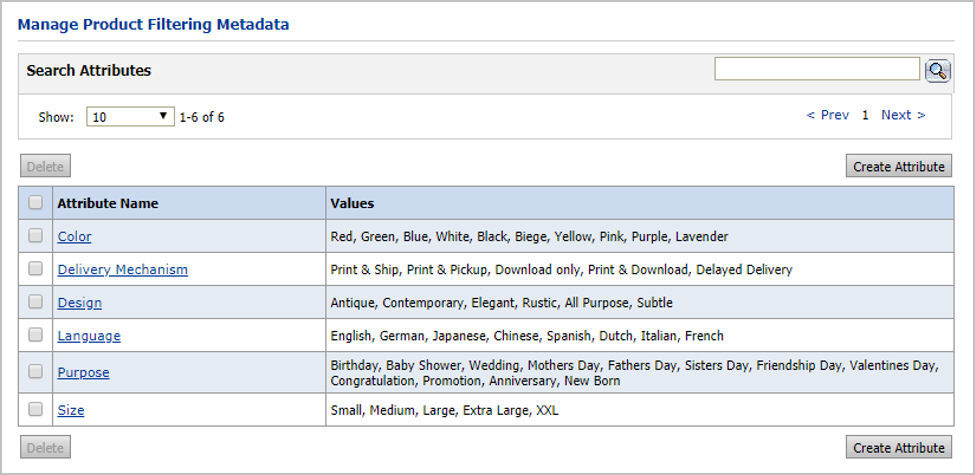
A matrix product is a composite product (which, like a kit product, is a product composed of two or more other products) that combines two or more related products into a single product with various options so that buyers have a convenient way of choosing the options they want. For example, say you offer a spirit-wear T-shirt in three colors (red, blue, and green) and 4 sizes (small, medium, large, and extra large). Instead of publishing each variation (e.g., a small red shirt, a small blue shirt, etc.) as a separate product on the storefront, when you create a matrix product, you will publish one product on the storefront (e.g., "SpiritWear T-Shirt") and buyers will be able to select the color and size they want from pull-down lists.
When creating a variation (option) product, you will choose the attributes (size, color, quality, etc.) that apply to the product from the matrix of attributes you have set up and map the variation products. Buyers who select the T-shirt product on the storefront will be presented with all the options you have set up for the single product.
Note: Matrix products are available only on SmartStores, not on classic storefronts.
The setup process for has three main tasks:
(1) Create a matrix of attributes (product filtering metadata) that defines all attributes to use in your products such as size (e.g., small, medium, large, extra large) and color (e.g., red, white, blue) on the Manage Product Filtering Metadata page.
(2) Create a product for each variation of the product you want to offer (e.g., a small blue T-shirt, a medium blue T-shirt, a large blue T-shirt, etc.) selecting the appropriate attributes and map each attribute to the appropriate variation product.
(3) Publish the product on the storefront to make it available to buyers.
The following are just a few of the common use cases for matrix products:
● Offer
a document such as a book or manual in two formats.
For example, you could offer a handbook in either printed format or digital
format, by including (mapping to the product) both a static version and
a digital download version.
● Offer
non-printed products such as T-shirts, pens, or coffee mugs in several
sizes, colors, or models.
For example, you could offer a T-shirt in four sizes and four colors so
that buyers can select the T-shirt product and then select a color and
size.
● Offer
digital download products such as eBooks or software applications in various
formats.
For example, you could offer an eBook in .epub, .mobi, or .pdf format.
● Offer
ad hoc products in various quality levels.
For example, you could offer a buyer the option of having an ad hoc printed
product document produced in three quality levels (good, better, best)
or in two modes (color or black-and-white).
Note: Matrix products are ideal for offering variations of non-printed, digital download, and ad hoc products. The product matrix is made up of product attributes (such as size, color, shape, theme, region, gender, quality, style) and attribute values (such as small, medium large; red, green, blue; male, female).
Note: Matrix products can include products of different types (e.g., a static product plus a digital download).
Creating a matrix product involves two main tasks:
(1) Define the attributes for the products (such as "size," "color," "delivery format") on the Manage Product Filtering Metadata page.
Note: You can skip this step if all attributes you want to offer as variants of the product are already defined. The image below shows a Manage Product Filtering Metadata page with a number of attributes (keys and key values) defined.

(2) Create a product for each of the options in the matrix product.
Note: For example, if you are creating a shirt that comes in three colors (red, blue, and green), you will need to create three products: one red shirt product, one blue shirt product, and one green shirt product. You will then associate the product with the matrix product that you will create in step 3. Create the product following the steps in the Create Products help topic. After all products to be included in the matrix product have been created, return to this help topic for the steps to create the matrix product. If all the products you want to include in the matrix product have already been created, you can skip this step.
(3) Create the product on the Manage Products page, selecting the product type "Product Matrix."
1. Go to Administration > Manage Product Filtering Metadata.
2. On the Manage Product Filtering Metadata page, click Create Attribute.
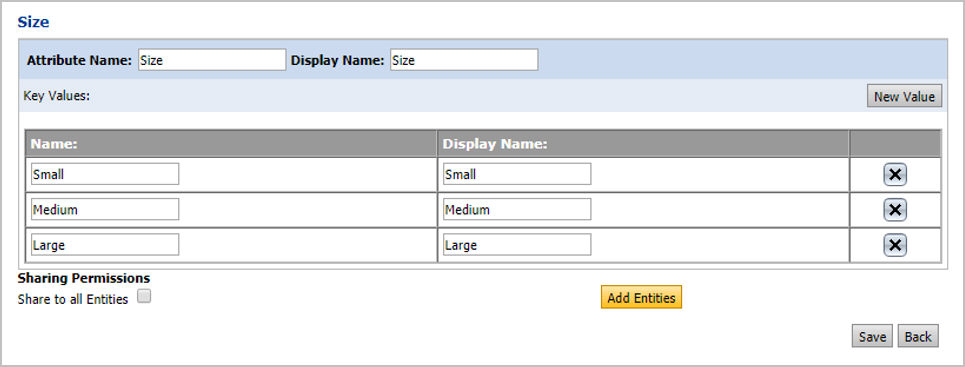
3. On the Create Attribute dialog:
● Attribute Name: Enter a name for the key (attribute), such as "Size" or "Color."
● Display Name: Enter a name for the attribute that will be shown to buyers when ordering on the storefront.
● Define the values for the attribute:
Note: A value is one of two or more options for the selected attribute; for instance a value for the attribute "Color" might be "Green"; a value for the attribute "Size" might be "Small").
● Name: Enter a name for the value (such as "Blue" or "Large").
● Display Name: Enter a name for the value that will be shown to buyers as a selection when ordering on the storefront.
● Click New Value to add another key value.
● Click Save.
Enterprise Model Note: If you want to share the Product Filtering Metadata with other entities, in the Sharing Permissions section of Create Attribute Page, select the Share to all Entities check box if you want to share with all entities, or click Add Entities to specify the entities to which you want to share the Filtering Metadata. Attributes will be in “read only” mode, if it has been shared by the parent entity and can be added/deleted/edited only by the parent entity that created this attribute.
Once you have defined the key (attributes) you want to make available for the new product matrix product, you are ready to create the new product.
1. Go to Administration > Products.
2. On the Manage Products page, click Create Product.
3. From the Type pull-down list, select Product Matrix.
4. Click Next.
1. Product Name: Name of the product for administrative purposes. It can be the same as the displayed name. This is the only field required to make a product. The product name can include up to 50 characters.
Note: Product names cannot include the characters &# together because that is the HTML code for the fraction 1/4.
2. Display As: Can be a more buyer-friendly name of the product that will appear to buyers on the product pages on the storefront.
3. Product ID: Product code or SKU. The product name can include up to 50 characters. To take advantage of deep linking, be sure to use unique product IDs (SKUs).
4. Direct Product Link: A direct "deep link" to the product (the field will be visible only after you have entered a Product ID and saved the product).
Note:
This is a "deep link" to
the product file that links to a specific page where the product file
is located. A deep link is a link that bypasses the site navigation and
takes the buyer directly to a specific product page in MarketDirect StoreFront. The
purpose of such a deep link to the product is to ensure that the product
remains accessible. For instance, if you copied the link to a product
from the browser’s address
field the link could not be expected to remain valid because such links
are typically encrypted and cannot be guaranteed to remain functional
from one version of MarketDirect StoreFront
to the next. Direct product links prevent this problem by making certain
links (to categories and products) both permanent and short.
IMPORTANT NOTE for cloud (EFI-hosted)
customers: You will not see a link in the Deep
Product Link field. For direct product linking to work you will
need to:
(1) Make sure that a unique Product
ID (SKU) is applied to the product (in the previous step).
(2) Use the following format to create the URL for the deep link to the
product: http://[MyPrintSite]/DSF/PRODUCTS/SKU/[productSKU].aspx
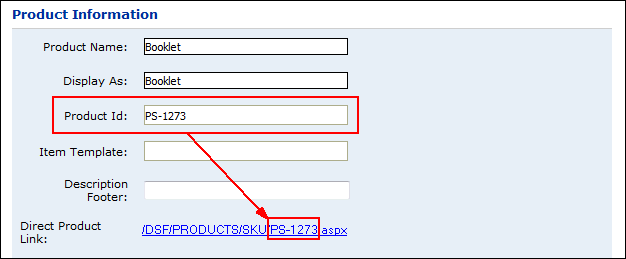
TIP: If you are printing collateral
for your business that includes QR (quick response) codes, you can use
QR codes to promote your own content including StoreFront promotions to
drive online sales. By combining the “Deep Linking” feature of MarketDirect StoreFront with
a QR code, you can promote many different types of content, including
an online product promotion, customer-facing tips on creating VDP collateral,
your booth location at an upcoming tradeshow, etc. Leveraging QR Codes
and Deep Links to share content and drive promotions on your storefront
can help grow your business.
Using Deep Links in Customer Communications (such
as in email or Web links)
Appending ?cmd=begin
to a deep link to a product will take the buyer to the product ticketing
page for a product (i.e., eliminating the need for the buyer to click
Begin to begin ordering the product).
For example, if your deep link to the product is
http://[MyPrintSite]/DSF/PRODUCTS/SKU/[productnameorSKU].aspx
you could append ?cmd=begin to
it as shown below
http://[MyPrintSite]/DSF/PRODUCTS/SKU/[productnameorSKU].aspx?cmd=begin
to take a prospective buyer directly to the product ticketing page for
a Visual Product Builder (i.e., for products that use the Flex ticket)
product (so the buyer can begin selecting options for the product).
This is a great way to link to a product your are promoting in your marketing
materials, Web sites, the footer of an email message (for information
on how to add a custom footer to email see To
customize the header and footer for site-level email notifications),
etc.
Note on Deep Links with Login Bypass:
To navigate to the product ticketing page with login bypass, append the
following code to the deep link after ?cmd=begin:
ssotok= (followed by the user's
single sign on token) and &ssotokpwd=
(followed by that user's password). Thus, the deep link will be in this
format:
http://[MyPrintSite]/DSF/PRODUCTS/SKU/[productnameorSKU].aspx?cmd=begin&ssotok=[User
Profile Single Sign On Token]&ssotokpwd=[User Password]
If you do not use login bypass
with the deep link, the deep link will take buyers to a default storefront
landing page that will require them to log into the site. If the buyer
does not have an account on the site and chooses
to register, is likely that he or she will be registered for the wrong
company/storefront.
5. Type: Display only product type that you selected on the previous page.
6. Brief Description: Enter descriptive text for the product that will be displayed to buyers on the storefront. This brief product description is augmented by a longer description that is displayed on an entire page when buyers click for more information on a product. There is a 2,000-character limit for HTML text.
Warning: HTML text characters add up quickly, so when possible keep formatting simple.
Note: Most of the controls on the text editor will be familiar to users of word processing packages such as Microsoft Word or Corel WordPerfect. A few of the controls that might not be so familiar are:
Control |
Description |
|
This displays the text editor workspace in design mode, which means it will be displayed WYSIWYG (“what you see is what you get”). |
|
This displays the text editor workspace in HTML mode, which means you can use standard HTML formatting tags to define how your text will appear (e.g., <b>Sale!</b> will cause the word “Sale!” to display in boldface on the storefront). |
|
This displays the text in the workspace without any formatting controls. |
7. Product Icon: The product icon is the image that will be used to represent the product on the storefront.
● For Classic storefronts: You can upload both a small and a large version of an image to represent the product.
● For SmartStore storefronts: You can upload a large image to represent the product.
● Click Edit.
● None: Click this radio button if you want no product image to appear on the storefront.
● Stock Icon Library: Click this radio button if you want to select an image from the stock icon library, which includes icons for nearly 30 product categories (e.g., binders, business cards, brochures, calendars).
● Upload Custom Icon: Click this radio button to select an image to display.
● Click Browse... and on the Choose File dialog navigate to the image file you want to display, select it, then click Open.
● Click Upload.
Note: To delete a product image, click Delete.
8. Click Details on the left navigation menu.
1. Long Description: Enter a detailed product description that will be displayed to buyers on the product details section on the storefront. There is a 4,000-character limit for HTML text.
2. Product Details Image: You can upload an image to represent the product to buyers on the storefront when they are viewing product details.
● Click Edit.
● None: Click this radio button if you want no product image to appear on the storefront.
● Upload Custom Icon: Click this radio button to select an image to display.
● Click Browse... and on the Choose File dialog navigate to the image file you want to display, select it, then click Open.
● Click Upload.
Note: To delete a product image, click Delete.
3. Click Settings on the left navigation menu.
1. Display Priority: Select a priority for the product from the pull-down list.
Note: This will specify the order from top to bottom in which the product will be displayed on the storefront, from Highest to Lowest; higher priority will cause the product to display higher on the storefront product page. If two or more products have the same display priority, they will be sorted alphabetically.
2. Valid Dates
● Active: Specifies whether the product status is active (available now or, for instance, is created now to be made active at a later time, such as when a sales promotion begins).
● Start Date: Use the calendar tool to specify the date on which the product should start being displayed on the buyer storefront.
● End Date: Use the calendar tool to specify the date on which the product should no longer be displayed on the buyer storefront.
● Select Never if you do not want the product display to expire on a specified date.
3. Mobile Supported:
● Select Yes if you want the product to be shown / available to buyers accessing the storefront on a mobile device.
● Select No if you want the product to be hidden / not available to buyers accessing the storefront on a mobile device.
4. Keywords: Enter any descriptive keywords that will help buyers searching for the product to find it.
Note: Separate keywords with a comma ( , ), spaces are not necessary, and note that your total character count for keywords cannot exceed 500.
5. Click Security on the left navigation menu.
Note:
Assigning Ownership and Access Rights
for the Product: In this section of the product builder you can
assign an owner for the product and set permissions to restrict access
to it. This enables you make the product available for editing and/or
publishing by a particular user or group of users. The security option
lets you assign management and publishing rights for a product:
Publish: can publish the product
for buyers on the storefront (this must
be used in conjunction with Manage rights; i.e., in order to publish a
product, which makes it available to buyers on the storefront, the user/s
must also have Manage rights).
Manage: can change a product by
accessing it on the Products page and editing its specifications.
1. Click Change to add or change who owns (is in charge of) the product.
2. On the Select Owner dialog:
● In the first drop-down select the category of user to assign ownership of the product to: Users, Groups, Companies, or Departments.
Note: Typically, this will be a user. The search field will help you locate the group or user you are looking for, and the Show field will limit the number of items displayed.
● Click the group or user to assign ownership to.
Note: The function of “owner” is to ensure that someone can always get to the product (even if s/he does not otherwise have access rights). It exists in order to prevent a situation in which you would inadvertently configure yourself out of access to the product.
3. Click Add User, Group, Company, or Department.
● On the Select Security Principal... dialog:
● In the first drop-down select the category of user to whom to assign access to the product: Built-in Groups, Users, Groups, Companies, or Departments.
Note: Typically, this will be a user or user group. The search field will help you locate the group or user you are looking for, and the Show field will limit the number of items displayed.
● Click the user or group to assign access to. The selected user or group will be shown on the Security page in the Access Permissions table. You can grant users the right to Publish and/or Manage (modify) the product.
Note: You can retract access permissions at any time by clicking Remove for the user, group, or company in the Access Permissions table on the Security page.
4. Click Check Permissions For... and select the user, group, or company whose permissions you want to check. A new dialog will display the permissions for the selected entity.
5. Click Next.
1. Click Select Attributes.
2. On the Select Attributes dialog, select the
attributes to use for this product.
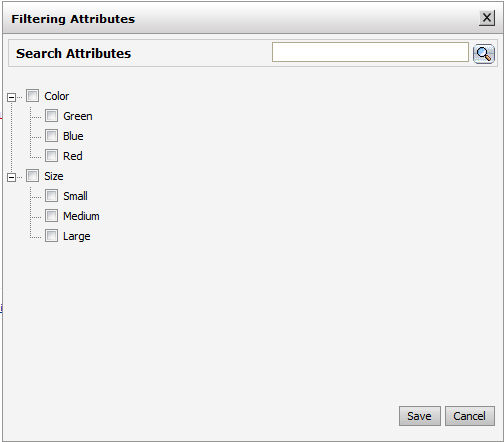
Note: For information on defining attributes and values on the Manage Product Search page, see Define the Attributes for Product Matrix Products.
3. Sort Order: You can set the sort order at the attribute level (to set the order in which the groups of attributes are displayed) and at the attribute values level (to set the order in which the values are displayed within an attribute group).
● To delete an attribute group or value,
click the  on
the appropriate level.
on
the appropriate level.
● Click Save.
4. When you have finished defining the attributes and values in your product matrix, click Next.
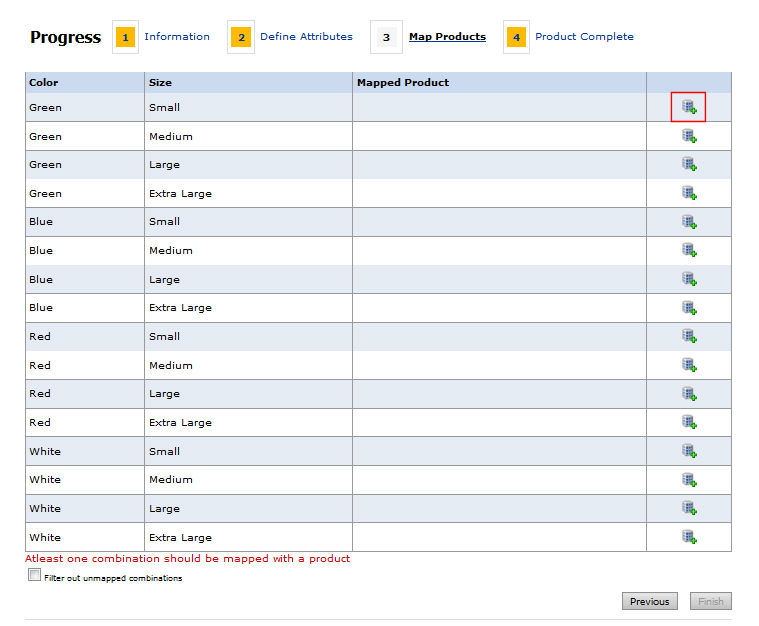
1. Click the map products icon.
2. On the Map Products dialog, select the product
to associate with the selected attribute/value combination.
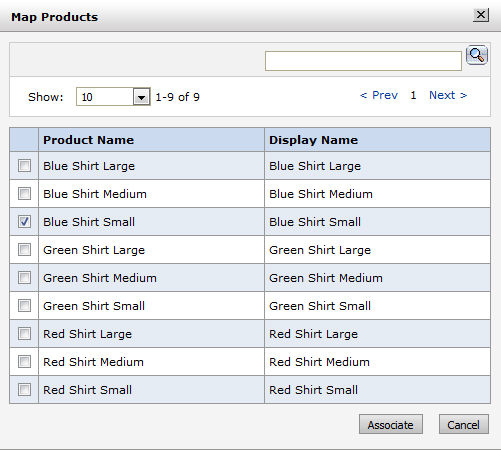
● Click Associate.
3. Repeat the steps above to map additional products to attributes/value combinations.
4. Select the checkbox Filter out unmapped combinations to prevent all unmapped options from being included in grayed-out form to buyers. If you leave this option unselected, the unmapped options will be included in the list of buyer selections but grayed out (and thus not selectable).
5. Click Finish.
 Product Complete page:
Product Complete page:1. Click Manage Products to return to the Manage Products page.
2. To publish the product to your storefront, click Publish It.
● On the Select Target Category dialog, select the category in which to display the product to buyers on your Web storefront.
● Click Publish.
● If you have a license for product-level punchout (to allow buyers to "punch out" to your site from a procurement site (e.g., Ariba) and want to publish the product on the procurement site, click Publish to External Catalog.
Note:
For more information on integrating your site with a third-party procurement
site such as Ariba, Coupa, or Four51, see Site
Settings - PunchOut Integration Tab and Punchout
Buyer Management.
For information on licensing the Punchout Buyers option, contact your EFI
MarketDirect StoreFront
Sales at http://efi.com/about-efi/contact-us/how-to-buy/.
● On the PunchOut Buyers dialog, select the external (i.e., punchout) site to publish the product to.
● Click Publish.
3. Click Finish.
4. Go to your buyer
Storefront and review the product as it will appear to buyers with the
attributes you defined presented in pull-down menus.
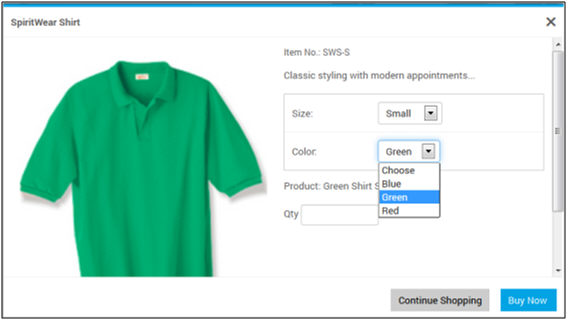
5. If changes need to be made, click Manage on the storefront and edit the product specifications.
● To manage products on the Manage Products page
● To create a variable data product (XMPie, FusionPro)